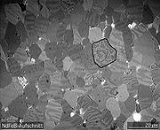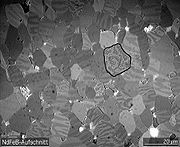
Magnetic domains
Encyclopedia

Magnetization
In classical electromagnetism, magnetization or magnetic polarization is the vector field that expresses the density of permanent or induced magnetic dipole moments in a magnetic material...
. This means that the individual magnetic moment
Magnetic moment
The magnetic moment of a magnet is a quantity that determines the force that the magnet can exert on electric currents and the torque that a magnetic field will exert on it...
s of the atoms are aligned with one another and they point in the same direction. When heated above a temperature called the Curie temperature, a piece of ferromagnetic material undergoes a phase transition
Phase transition
A phase transition is the transformation of a thermodynamic system from one phase or state of matter to another.A phase of a thermodynamic system and the states of matter have uniform physical properties....
, and the uniform magnetization within a domain spontaneously disappears: each atom has its own direction of magnetic moment, independent from its neighbouring atoms (typical of the paramagnetic state
Paramagnetism
Paramagnetism is a form of magnetism whereby the paramagnetic material is only attracted when in the presence of an externally applied magnetic field. In contrast with this, diamagnetic materials are repulsive when placed in a magnetic field...
). Magnetic domain structure is responsible for the magnetic behavior of ferromagnetic materials like iron
Iron
Iron is a chemical element with the symbol Fe and atomic number 26. It is a metal in the first transition series. It is the most common element forming the planet Earth as a whole, forming much of Earth's outer and inner core. It is the fourth most common element in the Earth's crust...
, nickel
Nickel
Nickel is a chemical element with the chemical symbol Ni and atomic number 28. It is a silvery-white lustrous metal with a slight golden tinge. Nickel belongs to the transition metals and is hard and ductile...
, cobalt
Cobalt
Cobalt is a chemical element with symbol Co and atomic number 27. It is found naturally only in chemically combined form. The free element, produced by reductive smelting, is a hard, lustrous, silver-gray metal....
and their alloy
Alloy
An alloy is a mixture or metallic solid solution composed of two or more elements. Complete solid solution alloys give single solid phase microstructure, while partial solutions give two or more phases that may or may not be homogeneous in distribution, depending on thermal history...
s, ferrite
Ferrite
Ferrite may refer to:* Ferrite , iron or iron alloys with a body centred cubic crystal structure.* Ferrite , ferrimagnetic ceramic materials used in magnetic applications....
s etc. The regions separating magnetic domains are called domain wall
Domain wall
A domain wall is a term used in physics which can have one of two distinct but similar meanings in magnetism, optics, or string theory. These phenomena can all be generically described as topological solitons which occur whenever a discrete symmetry is spontaneously broken.-Magnetism:In magnetism,...
s, where the magnetisation rotates coherently from the direction in one domain to that in the next domain.
Development of domain theory
Magnetic domain theory was developed by French physicist Pierre-Ernest Weiss who in 1906 suggested existence of magnetic domains in ferromagnets. He suggested that large number of atomic magnetic moments (typically 1012-1018) were aligned parallel. The direction of alignment varies from domain to domain in a more or less random manner although certain crystallographic axis may be preferred by the magnetic moments, called easy axes. Weiss still had to explain the reason for the spontaneous alignment of atomic moments within a ferromagnetic material, and he came up with the so-called Weiss mean field : he assumed that a given magnetic moment in a material experienced a very high effective magnetic field due to the magnetization of its neighbours. In the original Weiss theory the mean field was proportional to the bulk magnetization M, so that
where
 is the mean field constant. However this is not applicable to ferromagnets due to the variation of magnetization from domain to domain. In this case, the interaction field is
is the mean field constant. However this is not applicable to ferromagnets due to the variation of magnetization from domain to domain. In this case, the interaction field is
Where
 is the saturation magnetization at 0K.
is the saturation magnetization at 0K.Later, the quantum theory made it possible to understand the microscopic origin of the Weiss field. The exchange interaction
Exchange interaction
In physics, the exchange interaction is a quantum mechanical effect without classical analog which increases or decreases the expectation value of the energy or distance between two or more identical particles when their wave functions overlap...
between localized spins favored a parallel (in ferromagnets) or an anti-parallel (in anti-ferromagnets) state of neighbouring magnetic moments.
Energy considerations

Landau and Lifshitz [1] proposed theoretical domain structures based on a minimum energy concept, which forms the basis for modern domain theory. The primary reason for the existence of domains within a crystal is that their formation reduces the magnetic free energy. In the simplest case for such a crystal, the energy, E, is the sum of several free energy terms:
 (3)
(3)where Eex is the exchange energy, Ek is the magnetocrystalline anisotropy energy, Eλ is the magnetoelastic energy, ED is the magneto-static energy, and EH is the Zeeman energy, i.e. the energy of the magnetic material in the presence of an external applied field. A wall energy Ew could also be added. However, since Ew comprises Eex and Ek, it is not necessary to include Ew as a separate term in the equation.
- Magneto-static energy: This is a self-energy, due to the interaction of the magnetic field created by the magnetization in some part of the sample on other parts of the same sample. Intrinsically, it has exactly the same nature as the "Zeeman energy" but the interaction of the material with itself is put in the magnetostatic energy whereas the interaction with the external magnetic field is put in the "Zeeman energy". This energy term is the only one responsible for the presence of magnetic domains in magnetic materials. Minimizing its value requires that the magnetization in the material makes closed loops, with the magnetization staying parallel to the sample edges.
- Magnetoelastic anisotropy energy: This energy is due to the effect of magnetostrictionMagnetostrictionMagnetostriction is a property of ferromagnetic materials that causes them to change their shape or dimensions during the process of magnetization. The variation of material's magnetization due to the applied magnetic field changes the magnetostrictive strain until reaching its saturation value, λ...
, a slight change in the dimensions of the crystal when magnetized. This causes elastic strains in the lattice, and the direction of magnetization that minimizes these strain energies will be favoured.
- Magnetocrystalline anisotropy energy: The crystal lattice is 'easy' to magnetize in some directions and 'hard' to magnetize in others. Magnetization in the easy directions lowers this energy.
- Zeeman energy: Energy resulting from the interaction between the magnetic material and an externally applied magnetic field.
Domain observation
There are many ways to observe magnetic domains. Each method has a different application because not all domains are the same. In condensed matter, domains can be circular, square, irregular, elongated, and striped, all of which have varied sizes and dimensions. Large domains, within the range of 25-100 micrometers can be easily seen by Kerr microscopy, which applies a physical phenomenon called the magneto-optic Kerr effectMagneto-optic Kerr effect
Magneto-optic Kerr effect is one of the magneto-optic effects. It describes the changes of light reflected from magnetized media.-Definition:The light that is reflected from a magnetized surface can change in both polarization and reflected intensity...
. Other domains, such as domains within the range of a few nanometers can be documented by the use of magnetic force microscopy.
Images
External links
- Interactive Java tutorial on magnetic domains National High Magnetic Field Laboratory
- Magnetismus und Magnetooptik a German text about magnetism and magneto-optics

